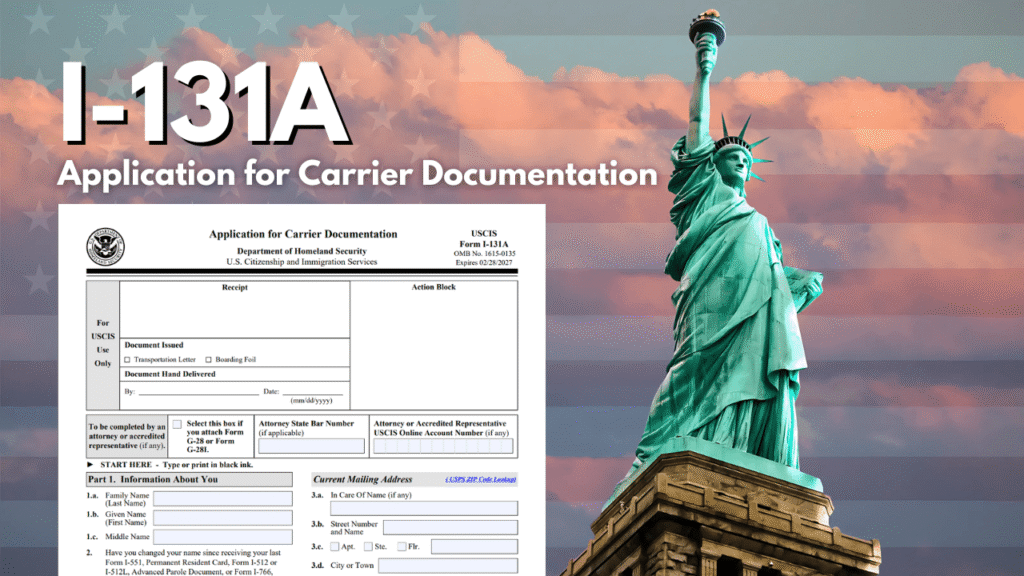A New Path to the United States,
I-131A, Application for Carrier Documentation (Lost/Stolen Green Card)

Forms and Document Downloads
Everything You Need to Know About Form I-131A: A Path Back to the U.S. After Losing Your Green Card
Losing your green card while abroad can be incredibly stressful—but there is a solution. Form I-131A is a critical tool that allows certain lawful permanent residents to return to the United States and later reapply for their green card. It’s not a simple process, and there are some surprising uses for this form that many don’t know about. Let’s break it down.
What Is Form I-131A?
Form I-131A, Application for Travel Document (Carrier Documentation), helps green card holders who are temporarily outside the U.S. and unable to board a flight back because they lost their green card or reentry permit. It’s designed to get you back to the U.S., where you can formally replace your green card.
The Real Problem: Denied SB-1 Visas
You might think going to the local U.S. consulate to get a travel document is straightforward. But over the last two years, many consulates have been denying SB-1 Returning Resident Visas at an alarming rate.
We’ve seen countless cases where clients were left stranded after their SB-1 applications were denied. That’s when we turn to Form I-131A as an alternative solution.
Where to File
Filing Form I-131A (Travel Document Replacement)
You must file in person at a U.S. Embassy or Consulate’s Consular Section.
Before your visit:
- Pay the filing fee online via the USCIS website.
- Bring proof of payment—either a confirmation page or email receipt.
Form I-131A Filing Fee
Check the current fee on the USCIS Fee Schedule page.
Anyone can pay from anywhere in the world—just enter the correct name, date of birth, and A-Number from your Green Card, reentry permit, or advance parole document.
Payment must be made online using a credit/debit card or a U.S. bank account.
Save your confirmation page or email receipt—you’ll need to show it when you file in person.
🚫 No fee waivers allowed.
🚫 Fees are final and non-refundable, even if your application is denied or withdrawn. Credit card charges can’t be disputed later.
❗ Filing more than one form? Pay each fee separately—combined payments may get your whole package rejected due to system issues.
How Does I-131A Work?
The process starts in the U.S., where the form is filed online. After payment, you schedule an interview with a U.S. consulate abroad. Once approved, the consulate issues a boarding foil or letter, which you present to the airline to confirm you’re authorized to return to the U.S.
Important Note: This letter doesn’t guarantee U.S. entry. Upon arrival, a Customs and Border Protection (CBP) officer will still decide whether to admit you. However, getting on the plane is often the biggest challenge, and that’s where I-131A shines.
Why Airlines Make It Difficult
Airlines face serious penalties if they bring passengers to the U.S. who are later denied entry. As a result, they’re very cautious and often refuse boarding unless there’s an official letter from the consulate. That’s why this boarding document is critical.
SB-1 vs. I-131A: What’s the Difference?
- SB-1 Visa: Allows both boarding and re-entry into the U.S.
- I-131A: Allows boarding only. You still need to prove to CBP that you haven’t abandoned your green card.
Once you’re back in the U.S., you’ll need to file Form I-90 to officially replace your lost green card.
The “Secret” Use of I-131A
Now, here’s where it gets interesting.
Due to ambiguous language in the policy when I-131A was first introduced, some consulates interpreted the one-year rule differently. According to their interpretation, as long as you file and pay for the I-131A within one year of leaving the U.S., you’re eligible—even if the interview and approval come many months later.
This flexibility allowed some green card holders to remain outside the U.S. for over a year without being automatically considered to have abandoned their residency.
But beware: Not all consulates follow this interpretation. It varies greatly depending on the location, so it’s essential to check with the specific consulate you’ll be working with.
I-131 vs. I-131A: Know the Difference
Don’t confuse these two forms:
- I-131 (Reentry Permit): Filed before leaving the U.S. if you plan to be abroad for an extended time.
- I-131A (Carrier Documentation): Filed from abroad if you lost your green card and need permission to return.
They serve completely different purposes and are not interchangeable.
Final Thoughts
Understanding the nuances of the I-131A process—especially the variable consulate interpretations—can save you time, stress, and potential denial of re-entry. At Zion Associates, we’ve helped hundreds of clients navigate this exact situation.
If you’re unsure about your options or need personalized guidance, we’re here to help. Sometimes a simple consultation is all it takes to set things straight.